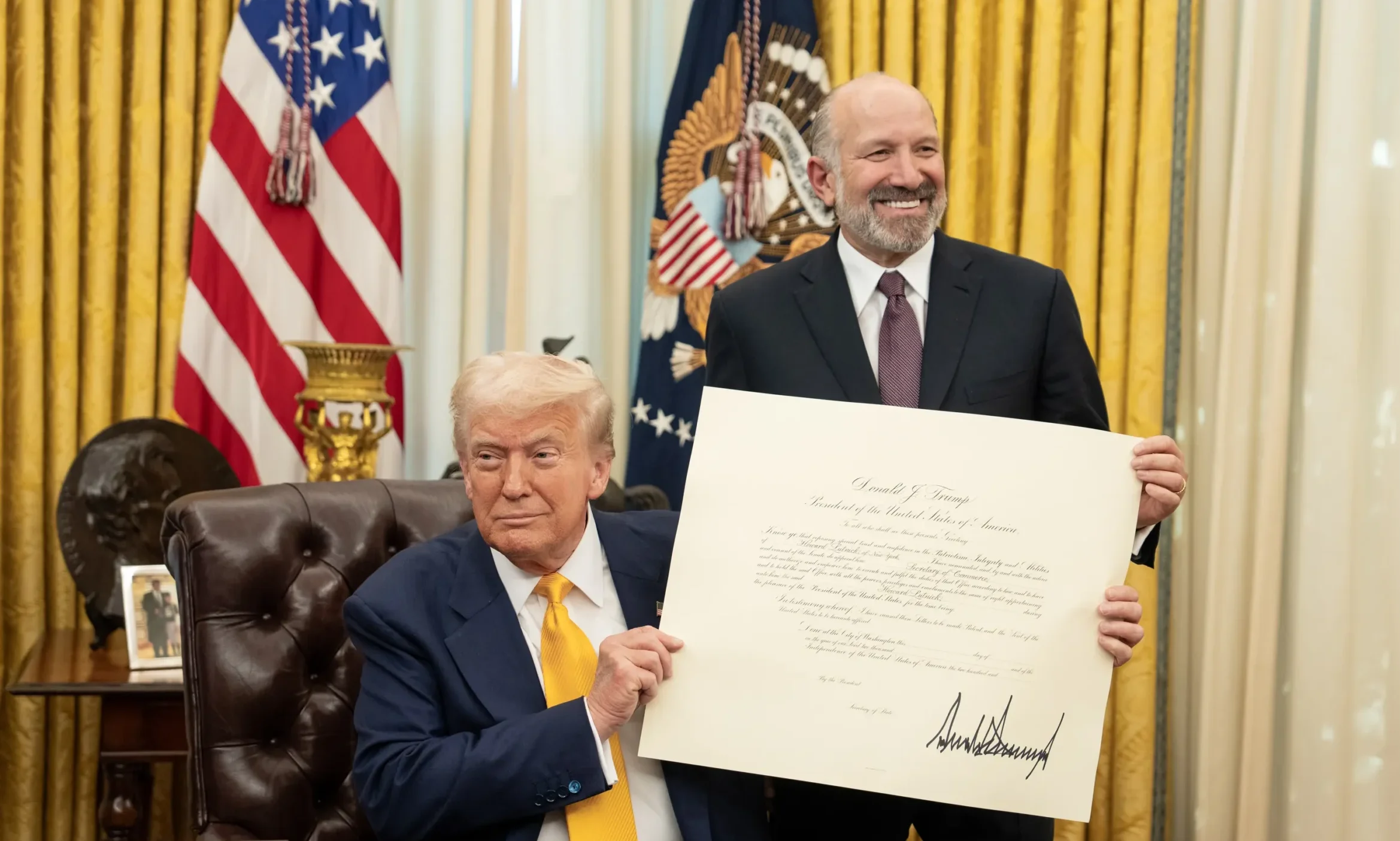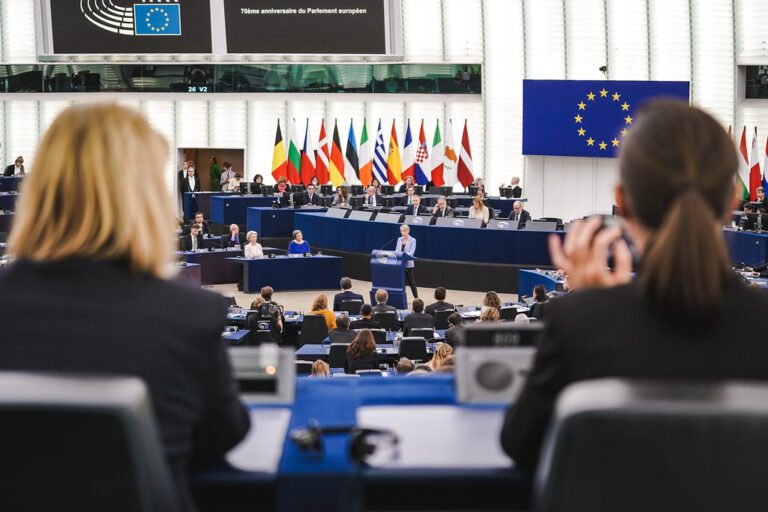
The Liberation Day tariffs took many by surprise. In addition to raising the baseline tariff on all US imports to 10 percent, the Trump administration introduced a series of new reciprocal and sector-specific tariffs in a bold attempt to reshape the global trading system. And while China has borne the brunt of these measures, several key US allies have also been targeted, including the EU, Taiwan, Japan, and South Korea.
Although Washington has since announced a 90-day pause on tariffs for most countries – with the exception of China – the damage may already be done, as several countries are now rethinking the reliability of the United States as not only their major economic but also security partner. In this context, CHOICE has invited several analysts to share their perspectives on the US’s evolving tariff strategy and its implications for the US allies.

Dominika Remžová
China Analyst at the Association for International Affairs (AMO)
The United States and China appear to be locked in a full-fledged trade war, with Washington imposing 145 percent tariffs on Chinese goods and Beijing responding with 125 percent tariffs on American products. While much of the discussion has focused on which country will bear the brunt of this stand-off and whether China’s ongoing charm offensive will succeed in getting more countries on its side (as currently on display during Xi’s tour of Southeast Asia, where several countries have been hard hit in a seeming attempt to crack down on China’s practice of transshipment and disrupt the delicate balancing act the countries have tried to pursue between the two great powers), the omissions and reversals are just as interesting.
Both countries will undoubtedly suffer. While the tariffs are expected to increase inflationary pressures in the US, China will need to find alternative markets to absorb its significant trade surplus. Indeed, despite Beijing’s long-standing policy of dual circulation and efforts to boost domestic consumption – with the tariffs likely leading to further monetary and fiscal easing – China’s export-oriented economy continues to rely on external markets to absorb its industrial overcapacity, leaving it in a vulnerable position. Considering the plethora of its domestic economic challenges, the trade war is certainly ill-timed for Beijing.
Yet, it is not only China that depends on the US, but the other way around, with China holding particularly strong leverage through global supply chains. It is through supply chains that the ripple effects of this bilateral conflict may prove especially devastating for the global economy, which must brace for major structural shifts. While China is a long-standing mercantilist power that has engaged with the neoliberal system only insofar as it served its own interests, the US now appears to be abandoning the very same system it once created – one that made the two largest economies interdependent in the first place.
Washington is aware of its own dependencies, as seen in the strategic exemptions for items like semiconductors and critical raw materials – areas where the US remains reliant on imports and cooperation with other countries, namely Taiwan and China. In a similarly unsurprising move, China has retaliated with export controls on seven rare earth minerals, affecting not only the US’s industrial capacities but also defense capabilities, as several of these minerals are essential for weapons systems.
Moreover, the US tariff regime continues to be marred by reversals, which is not boosting the confidence of US consumers and investors, let alone its geopolitical allies – though concerns about closer alignment between these and China may be overstated, as due to their different structural positions in the global economy China will be unable (and certainly unwilling) to replace the US as a major importer of global goods and services.
All in all, it remains unclear when and how the tariff gambit ends, with both the US and China having several other measures at their disposal that they have yet to utilize. In the meantime, it is up to the rest of the world to adjust quickly and effectively to this new economic reality.

Alicia García-Herrero
Chief Economist for Asia Pacific at Natixis and Senior Research Fellow at Bruegel
US tariffs targeting Chinese goods – and potentially also European goods (though reciprocal tariffs on the European Union have been paused for 90 days) – are bound to have adverse effects on US allies. The question is whether this can lead to some sort of “rapprochement” between the EU and China, as both find themselves targeted by the US, albeit to different degrees.
While a shared interest in countering US trade aggression might offer a basis for short-term alignment, the fundamental asymmetries between the EU and China remain stark. The EU is committed to rules-based multilateralism, market transparency, and democratic values, whereas China’s state-led economic model and increasingly assertive geopolitical stance often run counter to these principles. Furthermore, China has a history of using economic dependencies for political leverage, as seen in its relations with Australia and Lithuania. Increased EU-China cooperation, therefore, risks undermining the EU’s strategic autonomy and exposing it to similar vulnerabilities.
While Trump’s return has led to a more confrontational transatlantic relationship, this alone does not warrant a pivot toward Beijing. The long-term security, technological, and ethical misalignments between the EU and China outweigh the benefits of tactical trade alignment. Instead, the EU should double down on diversifying supply chains, strengthening internal economic resilience, and deepening alliances with like-minded democratic partners in Asia and the Global South. Aligning more closely with China in response to US tariffs would risk weakening the EU’s normative power on the global stage. Strategic patience and self-reliance – not alignment with Beijing – should guide Europe’s response to US protectionism.

Vida Macikenaite
Assistant Professor at the International University of Japan
Japanese Prime Minister Shigeru Ishiba has described the US tariffs on Japan as a “national crisis,” pledging a “whole-of-Japan” effort to respond. Indeed, Japan has much at stake. One-fifth of its exports go to the US – Japan’s largest export market – with 28 percent of that consisting of automobile shipments. Even as further tariff hikes are currently on hold, a 10 percent universal rate remains in place, along with a 25 percent duty on cars, which may be especially painful for Prime Minister Ishiba, whose approval rating stands at just 31 percent.
The Minister of Economic Revitalization, Ryosei Akazawa, who is due to conduct negotiations with the US officials in Washington on April 17, has carefully expressed his intent to reach an agreement. He emphasized the need “to listen to America’s concerns” before seeking a mutually acceptable solution. It seems that Tokyo appears to be pursuing a reconciliatory approach, having ruled out the option of imposing retaliatory tariffs. At the same time, Ishiba expressed doubts about the effectiveness of making concessions to the US.
The US tariffs only reinforced the notion in Tokyo that it needs to rethink its regional partnerships. Even before the current US administration took office, there were signs that Japan might be warming up toward China. In March, bilateral meetings on trade were held, and after a six-year break, Japan and China resumed the High-Level Economic Dialogue. The uncertainty introduced by the US administration seems to have also pushed China, Japan and South Korea closer together, as they recently agreed to continue trilateral economic and trade cooperation to address “emerging challenges.”
As China encourages other countries to push back against US tariffs, it remains to be seen where and how Japan repositions itself in the newly emerging global economic order. With Ishiba unable to conceal his disappointment over this kind of treatment by a traditional ally, Japan seems to be reassessing its relationship with China beyond the realm of tariffs alone.

Senior Affiliate Research at FU Berlin and Senior Associate Fellow at EUROPEUM
President Trump’s renewed tariff agenda, designed to recalibrate US trade relationships under the banner of perceived “economic fairness,” has drawn in not just China – the US’s primary strategic competitor – but also key allies, including South Korea and the European Union. While China has been hit hardest, facing a punitive 125 percent tariff rate, South Korea has not been spared: a 25 percent tariff now applies to core Korean exports such as automobiles, steel, and aluminum. What is more surprising – and diplomatically jarring – is Seoul’s recent addition to the US Department of Energy’s “Sensitive Countries List,” a designation usually reserved for nations seen as security risks. Despite Seoul’s pleas, South Korea has been placed in the same administrative category as China, Russia, Iran and its long-time adversary, North Korea.
Unlike Beijing, which has responded with countermeasures and rhetoric of decoupling, South Korea has adopted a pragmatic, if uneasy, path. Acting President Han Duck-soo has prioritized diplomacy over retaliation, seeking to defuse tensions by highlighting Korea’s strategic contributions in shipbuilding, LNG cooperation, and regional security. This approach mirrors the EU’s effort to pursue negotiation rather than confrontation – especially after Brussels reciprocated Washington’s 90-day tariff suspensions. South Korea’s position, however, remains more precarious. Unlike the EU, which retains institutional weight and influence within the transatlantic relationship, South Korea is caught in a more fragile equilibrium: too strategically important to alienate, but increasingly vulnerable to being leveraged in Washington’s broader economic and security recalibrations.
The convergence of trade policy and strategic mistrust could have lasting implications for South Korea’s foreign policy trajectory. If Washington continues to treat Seoul more as a liability than a partner, South Korea may be compelled to accelerate the diversification of its economic and technological ties – potentially with Brussels, but more likely albeit cautiously, with Beijing. The recent addition of Taiwan to the Sensitive Countries List raises further questions about Washington’s treatment of its close Indo-Pacific partners. While both South Korea and Taiwan now face new restrictions – especially on sensitive items like semiconductors – their strategic positions diverge: Taiwan remains a frontline actor in the US-China rivalry, while South Korea must balance its security concerns over Pyongyang with its export-dependent economy. As economic nationalism begins to reshape global alignments, South Korea’s challenge will be to defend its strategic autonomy without losing its standing in Washington – or becoming collateral in the next round of tariff diplomacy.

Zsuzsa Anna Ferenczy
Assistant Professor at National Dong Hwa University and Head of Associates Network at 9DASHLINE
As the dominant global power, America’s greatest asset has long been its robust network of allies and partners. No peer competitor can match this – for now. Yet, US President Donald Trump does not view allies as an integral part of US national and economic security. Instead, he is breaking agreements – and relationships – believing they stand in his way. Trump’s threat of tariffs to coerce, rather than coordinate with the EU, came as a shock to the bloc, with Vice-President JD Vance’s attacks on European democracy adding insult to injury. Still, perhaps this was the wake-up call Europe needed to emerge from its strategic slumber. Europe is now actively restructuring partnerships and rethinking its security capabilities – this time for real.
Faced with an existential threat from China, Taiwan has limited room to maneuver in response to Trump’s demands. Yet as the world’s 16th largest economy and a linchpin in global semiconductor supply chains, Taiwan plays an indispensable role. Chips are vital for the US to prevent China from becoming a regional hegemon. Working with companies in the US and Europe, Taiwan has effectively used its two greatest assets – its tech expertise and democratic resilience – to expand its international space and support US firms across the supply chain (rather than steeling American jobs, as Trump has claimed).
However, in Trump’s transactional worldview, such contributions hold little value. In contrast, for Europe, international law remains the guiding principle and is not negotiable – a position shared by Taiwan. A transatlantic rift is not what Europe, the US – or Taiwan – need. It is, however, exactly what China and Russia seek. So far, Trump seems to be doing them a favor. With the US undermining international law, Europe will face an even bigger challenge to uphold it. But a stronger Europe at home will ultimately translate to a stronger Europe in the Indo-Pacific – one Taiwan can count on.
In the meantime, Taiwan must stay focused on strengthening its defense by investing in asymmetric denial capabilities to become more self-reliant – a path that mirrors Europe’s own. Taiwan must also recalibrate its approach to Europe and invest more strategically – across party lines – in member states, especially those where it already enjoys solid relationships, such as Lithuania. This must be a priority, as Beijing is already doubling down on its charm offensive in Europe. The EU, along with individual member states and Taiwan, must become more creative in efforts to adapt to transactional America.
Written by
Dominika Remžová
DominikaRemzovaDominika Remžová is a China Analyst at AMO, specializing in Chinese economy and industrial policy, supply chains, critical raw materials, electric vehicles and, more generally, Chinese foreign policy. In the past, she contributed to Taiwan Insight and The Diplomat, among others. Dominika is pursuing her PhD in Political Science and International Relations at the University of Nottingham. She earned her Master's degree in Taiwan Studies from the School of Oriental and African Studies (SOAS) in London and her Bachelor's degree in Chinese Studies from the University of Manchester.
Alicia Garcia-Herrero
AligarciaherrerAlicia García Herrero is the Chief Economist for Asia Pacific at Natixis and Senior Research Fellow at Bruegel.
Vida Macikenaite
VidaMaciVida Macikenaite is an Assistant Professor at the Graduate School of International Relations, International University of Japan. Her research focuses on Chinese foreign policy and international relations in the region surrounding China.
Tereza Novotna
TerezaANovotnaDr. Tereza Novotna is a Nonresident Pacific Forum Kelly Fellow, 9DashLine Senior Associate, Senior Affiliate Researcher at Free University Berlin, and a Senior Associate Fellow at EUROPEUM Prague. She has been working on Europe-Asia and Europe-Indo-Pacific relations with a special focus on North and South Korea. She holds a Ph.D. from Boston University and other degrees from Charles University.
Zsuzsa Anna Ferenczy
zsuzsettteZsuzsa Anna Ferenczy is a Ph.D. Assistant Professor, National Dong Hwa University, Hualien, Taiwan, Head of Associates Network at 9DASHLINE, former political advisor at the European Parliament.

